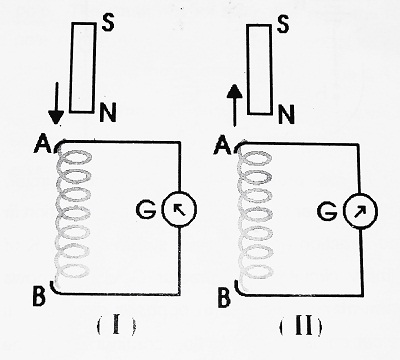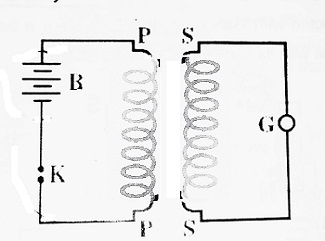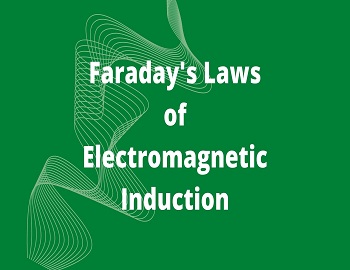Table of Contents
Faraday’s Laws of Electromagnetic Induction:
Faraday’s First Law of Electromagnetic Induction:
Statement- Whenever magnetic flux linked with the circuit changes, an induced EMF is produced in the circuit.
Explanation (Faraday’s Experiments)- Take a coil AB. The ends of the coil are connected with Galvanometer (G). Take a bar magnet with its N-pole towards the coil.

When we move the magnet towards the coil, the galvanometer shows deflection towards the left (say) and when we move the magnet away from the coil, the galvanometer shows deflection towards the right (say). Also, when we keep the magnet stationary near the coil, the galvanometer shows no deflection.
When we move the magnet toward the coil, magnetic flux linked with the coil increases (changes) and when we move the magnet away from the coil, magnetic flux linked with the coil decreases (changes). Also, when we keep the magnet stationary near the coil, the magnetic flux linked with the coil remains constant.
Thus, when there is a change in magnetic flux linked with the coil, an induced EMF is produced in the coil.
Another Experiment– Let us consider two circuits placed close to each other. One circuit contains battery B and key K. This circuit is called a primary circuit. The other circuit contains galvanometer G and is called a secondary circuit.

When we press key K, of the primary circuit, galvanometer G shows momentary deflection in one direction and when we switch off key K of the primary circuit, galvanometer G again shows momentary deflection in opposite direction. If the current is allowed to flow continuously in the primary circuit, then there will be no deflection in the galvanometer.
When we press the key K of the primary circuit, magnetic flux linked with the secondary circuit increases (changes) and when we switch off the key K of the primary circuit, magnetic flux linked with the secondary circuit decreases (changes) and when the current is allowed to flow continuously in the primary circuit, magnetic flux linked with secondary circuit remains constant.
Thus, when magnetic flux linked with the primary circuit changes, an induced EMF is produced in the secondary circuit.
Faraday’s Second Law of Electromagnetic Induction:
Statement- The magnitude of induced EMF produced in the circuit is directly proportional to the rate of change of magnetic flux linked with the circuit.
In Faraday’s Experiment, when the magnet is moved faster, the magnetic flux linked with the coil changes at a faster rate. Hence, the galvanometer shows more deflection and vice versa.
If ‘Φ1‘ be the magnetic flux linked with the coil at any time and ‘Φ2‘ be the magnetic flux linked with the coil after t seconds, then
| rate of change of magnetic flux = (Φ2 – Φ1)/t According to Faraday’s Second Law, e ∝ (Φ2 – Φ1)/t ⇒ e = k . (Φ2 – Φ1)/t In S.I. units, k = -1 e = (-1) (Φ2 – Φ1)/t If dΦ magnetic flux changes in time ‘dt’, e = (-1) dΦ/dt ⇒ e = -dΦ/dt |









Comments (No)